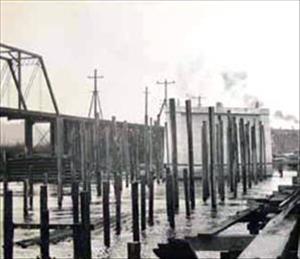Building over water can be difficult and dangerous. Before work began on the construction of the three central sections of the Puyallup Avenue Bridge, a total of four massive concrete piers were poured to support the structure -- one on each shore and two embedded in the Puyallup River itself. Because the river is shallow at the site and thus impassable to sizeable vessels, the bridge could be built as a fixed span, with no need for sections that could be raised or pivoted to allow for boat traffic to pass.
On construction drawings, the five truss sections of the bridge were labeled (moving from east to west) A, B, C, D, and E. "A" is the Warren truss on the Fife side of the river, "E" is the Baltimore petit truss on the Tacoma side, and "B," "C," and "D" are the three linked Pennsylvania petit truss segments that pass over the river.
Construction of the three central spans began on the west (Tacoma) side of the river, with Span D. Wooden falsework was build out over the river, the large longitudinal bottom girders supporting the bridge deck were put in place in sections, and the rest of the truss framework built in stages atop them. These main girders provide the primary support for the roadbed and, tied directly to the bridge's steel superstructure, become an integral part of the truss design. The entire truss "unit" -- bottom, sides, and top -- all linked together by welds and/or riveting, distributes the weight of the bridge itself (the dead load), the weight of the traffic thereon and the stresses it creates (the live load), and the lateral and vertical forces (called static and dynamic loads) caused by the wind. Expansion joints at set intervals were installed to permit minor changes in the bridge's length caused by seasonal temperature variations.
When Span D was substantially complete, the builders moved on to Span C, extending girders between the two mid-river piers, then erecting the sides and tops of the truss structure. In this gradual way, the workers progressed across the river form west to east. Span B was last, and when it was completed the preparations for paving these three segments could begin.
Contemporary photographs indicate that each of the three center truss sections of the bridge took about six weeks to construct. When the last was done, the Puyallup Avenue Bridge, while not quite complete, spanned the river from shore to shore. All that was left to do was removing the falsework, final paving, and minor detail work.









